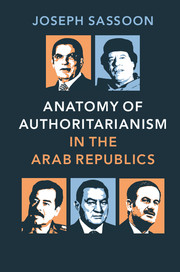Book contents
- Frontmatter
- Dedication
- Contents
- List of tables
- Acknowledgments
- Notes on transliteration
- Glossary and abbreviations
- Map of the eight Arab republics
- Introduction
- 1 Political memoirs in the Arab republics
- 2 Party and governance
- 3 The military
- 4 The role of security services in the Arab republics
- 5 Economy and finance
- 6 Leadership and the cult of personality
- 7 Transition from authoritarianism
- Conclusion
- Appendix Timeline of major events in the Arab republics
- Bibliography
- Index
Conclusion
Published online by Cambridge University Press: 05 March 2016
- Frontmatter
- Dedication
- Contents
- List of tables
- Acknowledgments
- Notes on transliteration
- Glossary and abbreviations
- Map of the eight Arab republics
- Introduction
- 1 Political memoirs in the Arab republics
- 2 Party and governance
- 3 The military
- 4 The role of security services in the Arab republics
- 5 Economy and finance
- 6 Leadership and the cult of personality
- 7 Transition from authoritarianism
- Conclusion
- Appendix Timeline of major events in the Arab republics
- Bibliography
- Index
Summary
The challenging question of whether dictatorship is beneficial for people economically or socially has long been argued by political economists. What is clear, as one of them observed, is that “dictators have a great capacity for action, good or bad.” Dictators can declare war, raise taxes, or introduce far-reaching social measures without much opposition. Some see strong executive power as a key reason for the economic success of Singapore and other East Asian countries. But prosperity was not the outcome in the eight republics studied here after three or four decades of authoritarian rule.
Although some dictators introduced significant social and educational reforms, such as improving the status of women, making education compulsory, and upgrading health services and infrastructure, the overall balance sheet of the “social contract” between leaders and citizens for the six decades preceding the Arab uprising was negative. Furthermore, much of the progress achieved was obliterated by military conflicts and civil wars in most of these countries, for which a heavy economic and social price was paid. National resources were diverted to the military and the security apparatus rather than toward strengthening the initial reforms. Thus, in reviewing the history of tyranny in the Arab world, it would be almost impossible to come up with a positive scorecard for the dictators’ policies. On the contrary, the catalogue of almost unmitigated disasters in all spheres is probably too long to list. What is evident is that these rulers did not respect the basics of the social contract with their people, and the engine of growth in their economies was very weak compared to the vitality of many other developing countries in Latin America or South-East Asia. The progress made in these Arab republics during the last half-century was mostly thanks to oil, remittances, or aid; not a recipe for a healthy economy.
At the beginning of this book I raised several questions about the anatomy of these authoritarian regimes. The first referred to their common denominators. These regimes shared most of the principal features of other authoritarian and totalitarian regimes outside the region, which can be summed up as:
politicizing all state institutions under the auspices of a ruling party, including political control of the military;
consolidating power and suppressing freedoms through wars, military conflicts, and fighting terrorism (Tunisia is a key exception);
- Type
- Chapter
- Information
- Anatomy of Authoritarianism in the Arab Republics , pp. 252 - 269Publisher: Cambridge University PressPrint publication year: 2016

